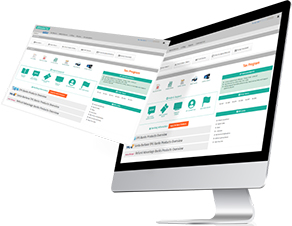Prepare for Disaster: Important Tips for Your Financial Safety
One of the most important things you need to discuss with your clients is financial safety. Clients will need to be aware of the possibility of the loss of personal records and the damage that can wreak on their financial health.
In some cases, the loss of IDs and documentation can be a mild inconvenience. This may incur a few costs—loss of time and effort in securing the documents anew.
But some documents are a lot harder to recover. The process of getting some records restored can be time consuming and expensive. Imagine having to recover all your financial, medical, insurance, business and other records.
Let clients know that they should think about what could happen in a natural disaster. Fire, hurricanes, floods and other dangerous events can wipe out years of documents in minutes. While recovery is possible, clients should try to avoid having to go through the arduous process.
Create an Emergency Plan
Every taxpayer needs to do all they can to safeguard their financial safety in case disaster strikes. One good place to start is the development of an emergency plan.
A disaster can happen at any time. Preparedness can minimize the effects of disaster on your family, business, and overall financial well-being.
Before making a plan, you should conduct a vulnerability assessment of your properties. Basically, you need to check out your properties and identify possible hazards and dangers that could affect them.
You may need professional advice to help you figure out what hazards could exist. You may be able to get your insurance provider to advise you on these matters. You can also seek assistance from your local fire department and police department.
When you create an emergency plan, provide a plan of action for every possible hazard. That can include what you can do to prepare for an emergency (like installing smoke alarms and fire extinguishers). It should also include what actions to take in the event of disaster (like communication and evacuation).
Update the emergency plan annually. You need to keep up with environmental and technological changes that can affect your disaster preparedness.
Document Your Valuables
While your property may be insured, you should also consider the process of making an insurance claim. You will want to do what you can right now to expedite the insurance claim process in the future.
One good way to do that: document your valuables. Take photos or videos of your personal belongings. Be sure to capture high-quality images of objects. They should be easy to identify on sight.
Also make a list of all your valuables. Take note of which ones are covered by your insurance. Also set down the present value of each item. Here’s a tip: go to IRS.gov and access the disaster loss workbook. It’s a helpful guide that taxpayers can use for creating a room-by-room list of personal valuables.
Save electronic copies of these images and documents. You should upload them to a cloud storage platform hosted by a reputable company. That will provide you with an online backup—preventing the loss of the documentation.
If disaster does strike, the documentation will make the process of claiming insurance and tax benefits a lot easier.
Electronic Documentation Is Vital
You may have a safe containing your important documents. Personal information records, medical records, property records, business documents, accounting ledgers, bank statements, tax returns, insurance policies, other financial records, and so on.
That’s good preparedness! But for the sake of financial safety, you need to do more. Make copies of all your documents and keep them in a separate location.
The next step is creating a digital backup. That means making electronic copies of all your documents. You may already have digital copies of your records (these are often PDF files). You can also have your documents scanned and saved as electronic files.
You can keep the electronic copies in your personal computer. But the files could get corrupted, deleted, or even encrypted due to a ransomware attack. A better solution would be to upload the files to cloud storage. That means the files are kept in a secure server hosted by a reputable web company. This means you have digital backups of all your files.
ProClient can safeguard your client records and other digital documents in secure cloud storage. It is one of the many features of the tax office management software.
In addition to cloud storage, you can have extra copies of your digital files stored on a USB or external hard drive. Keep these files in a separate location.
Learn More About Tax Relief
If one of your clients experiences a disaster, you can let them know that they can qualify for tax relief. You can direct them to IRS.gov to review the Disaster Assistance and Emergency Relief for Individuals and Businesses documentation.
In the case of a federally declared disaster, a taxpayer should check out Around the Nation on IRS.gov. They will be able to select their state to find out if disaster tax relief is available.
Taxpayers who live in counties that qualify for disaster relief can rest easy. They may be busy dealing with the aftermath of the disaster and thus, unable to promptly take care of tax relief requirements. Fortunately, they automatically receive filing and payment extensions for a lot of due tax forms. They don’t even need to contact the IRS to get relief.
Of course, you would be doing your client a service if you have familiarized yourself with the disaster assistance info. Then you can advise them directly about how to obtain tax relief. You can also reassure them—taking a compassionate approach is a good way to help someone who has lived through disaster.
Tips on the Tax Relief Process
Here are a few tips on the tax relief process. Advise your client to go through the itemized deduction for casualty and theft losses. Inform them that net personal casualty and theft losses may or may not be deductible. In many cases, the losses are deductible only to the extent to which they are attributable to a federally declared disaster.
When your client is making a tax relief claim, they should include the FEMA code assigned to the disaster.
Does your client need copies of previously filed tax returns? They can obtain copies of returns and attachments by filing Form 4506. They can also order transcripts online via Get Transcript on IRS.gov. The transcripts will include most line items. If they prefer to order transcripts over the phone, they can call this line: 800-908-9946
If your client has many questions, they can air their concerns directly with a disaster relief expert at the IRS. The number to call is 866-562-5227. That will connect them with an IRS specialist who is knowledgeable about disaster issues.
Ensuring Financial Safety with ProClient
As mentioned earlier, ProClient offers solutions for backing up tax returns and other vital tax records. You want clients to feel that their documents are safe and secure in your possession. You want to prevent any loss, theft, leaks, and other problems that could give your clients anxiety.
ProClient includes several features that can ensure client record safety. ProClient Portal provides a web interface that lets clients send you digital documents securely. The portal can only be accessed by the client using a unique username and password. The files uploaded via the portal are kept in cloud storage.
ProClient’s Document Center will only let an authorized tax preparer gain access to the uploaded client records. This allows an authorized user to obtain a backup copy of a file if needed. That means ProClient will help you prevent loss or damage to files containing client information.
Be prepared for disaster with good financial safety practices! Get ProClient to help you achieve this goal. You can get a free demo of ProClient! Click here to apply.






